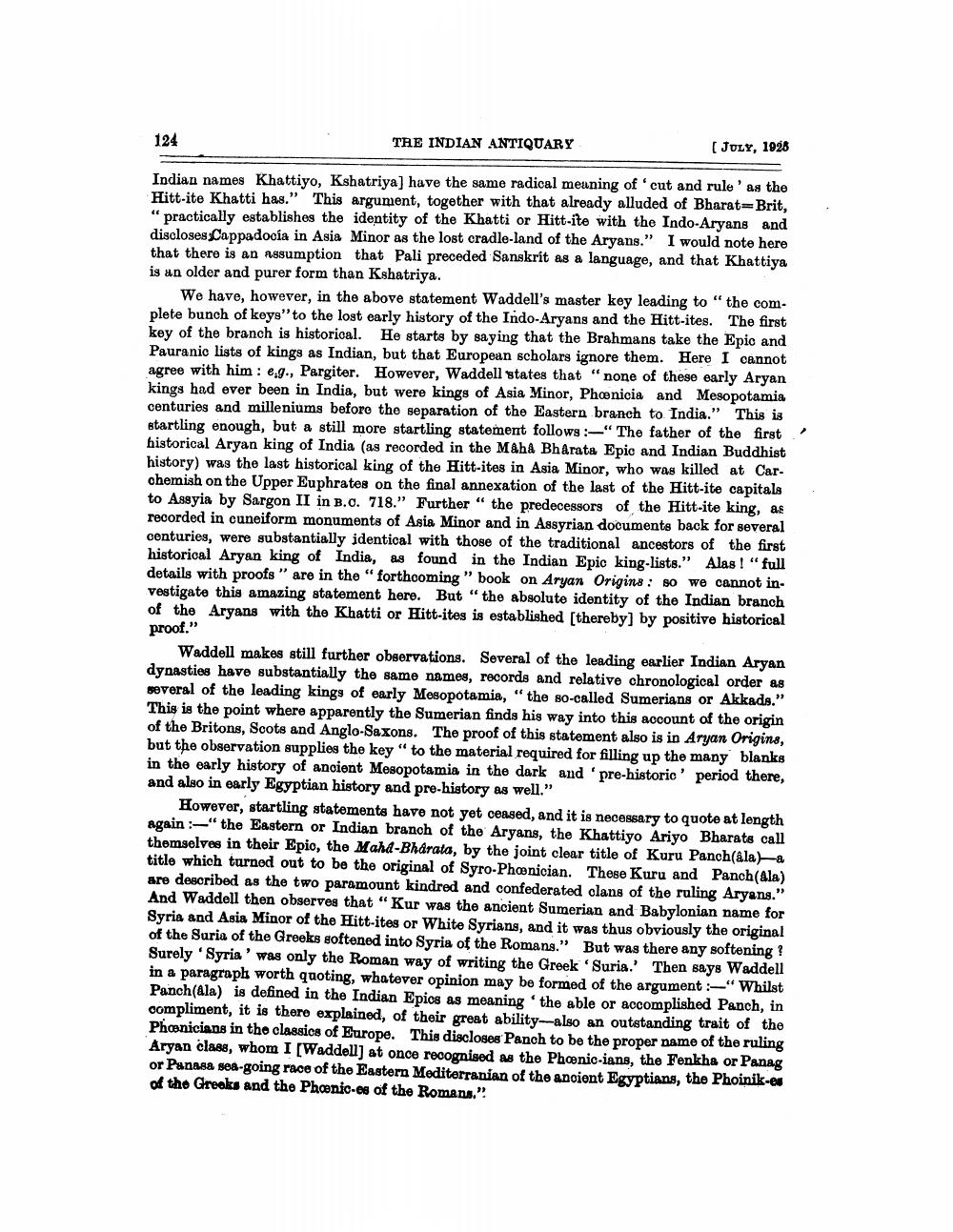________________
124
THE INDIAN ANTIQUARY
[JULY, 1928
Indian names Khattiyo, Kshatriya) have the same radical meuning of 'cut and rule' as the Hitt-ite Khatti has." This argument, together with that already alluded of Bharat-Brit, " practically establishes the identity of the Khatti or Hitt-ite with the Indo-Aryans and disclosessCappadocia in Asia Minor as the lost cradle-land of the Aryans." I would note here that there is an assumption that Pali preceded Sanskrit as a language, and that Khattiya is an older and purer form than Kshatriya.
We have, however, in the above statement Waddell's master key leading to "the complete bunch of keys" to the lost early history of the Indo-Aryans and the Hitt-ites. The first key of the branch is historical. He starts by saying that the Brahmans take the Epic and Pauranic lists of kings as Indian, but that European scholars ignore them. Here I cannot agree with him : e.g., Pargiter. However, Waddell states that "none of these early Aryan kings had ever been in India, but were kings of Asia Minor, Phoenicia and Mesopotamia centuries and milleniums beforo the separation of the Eastern branch to India." This is startling enough, but a still more startling statement follow "The father of the first historical Aryan king of India (as recorded in the Maha Bharata Epic and Indian Buddhist history) was the last historical king of the Hitt-ites in Asia Minor, who was killed at Carchemish on the Upper Euphrates on the final annexation of the last of the Hitt-ite capitals to Assyia by Sargon II in B.o. 718." Further " the predecessors of the Hitt-ite king, as recorded in cuneiform monuments of Asia Minor and in Assyrian documents back for several centuries, were substantially identical with those of the traditional ancestors of the first historical Aryan king of India, as found in the Indian Epic king-lists." Alas! "full details with proofs" are in the" forthcoming" book on Aryan Origins : 80 we cannot investigate this amazing statement here. But "the absolute identity of the Indian branch of the Aryans with the Khatti or Hitt-ites is established [thereby] by positive historical proof."
Waddell makes still further observations. Several of the leading earlier Indian Aryan dynasties have substantially the same names, records and relative chronological order as several of the leading kings of early Mesopotamia," the so-called Sumerians or Akkads." This is the point where apparently the Sumerian finds his way into this account of the origin of the Britons, Scots and Anglo-Saxons. The proof of this statement also is in Aryan Origins, but the observation supplies the key" to the material required for filling up the many blanks in the early history of ancient Mesopotamia in the dark and 'pre-historic' period there, and also in early Egyptian history and pre-history as well."
However, startling statements have not yet ceased, and it is necessary to quote at length again :"the Eastern or Indian branch of the Aryans, the Khattiyo Ariyo Bharats call themselves in their Epio, the Maha-Bharata, by the joint clear title of Kuru Panch(@la) & title which turned out to be the original of Syro-Phænician. These Kuru and Panch(Ala) are described as the two paramount kindred and confederated clans of the ruling Aryans." And Waddell then observes that "Kur was the ancient Sumerian and Babylonian name for Syria and Asia Minor of the Hitt-ites or White Syrians, and it was thus obviously the original of the Suria of the Greeks softened into Syria of the Romans." But was there any softening? Surely 'Syria' was only the Roman way of writing the Greek Suria.' Then says Waddell in a paragraphs worth quoting, whatever opinion may be formed of the argument "Whilst Panch(@la) is defined in the Indian Epics as meaning 'the able or accomplished Panch, in compliment, it is there explained, of their great ability-also an outstanding trait of the Phonicians in the classics of Europe. This discloses Panch to be the proper name of the ruling Aryan class, whom I (Waddell) at once recognised as the Phoenic-ians, the Fenkha or Panag or Panasa sea-going race of the Eastern Mediterranian of the anciont Egyptians, the Phoinik.es of the Greeks and the Phoenic-es of the Romans."




